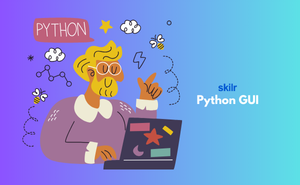👇 CELEBRATE CLOUD SECURITY DAY 👇
00
HOURS
00
MINUTES
00
SECONDS

Python GUI (Graphical User Interface) refers to the practice of using Python programming language and its libraries to develop user interfaces for software applications. The practice involves using Tkinter, PyQt, and Kivy for buttons, menus, text boxes, and other user interface elements for desktop applications on Windows, macOS, and Linux.
Certification in Python GUI certifies your skills and knowledge in using Python for developing graphical user interfaces for desktop applications on Windows, macOS, and Linux. The certification assess you in developing graphical user interfaces , event-driven programming, Tkinter, PyQt, and Kivy
Why is Python GUI certification important?
Who should take the Python GUI Exam?
Python GUI Certification Course Outline
The course outline for Python GUI certification is as below -
Industry-endorsed certificates to strengthen your career profile.
Start learning immediately with digital materials, no delays.
Practice until you’re fully confident, at no additional charge.
Study anytime, anywhere, on laptop, tablet, or smartphone.
Courses and practice exams developed by qualified professionals.
Support available round the clock whenever you need help.
Easy-to-follow content with practice exams and assessments.
Join a global community of professionals advancing their skills.
(Based on 560 reviews)
Job roles include Software Developer, Python Developer, UI Developer, Application Developer, and IT Support Engineer.
Skills tested include proficiency in Python programming, GUI design, event handling, layout management, and connecting Python code with a graphical interface.
Companies in software development, IT support, and web development industries such as Microsoft, IBM, Google, and smaller tech firms.
Certification demonstrates your ability to build and deploy functional desktop applications, improving job prospects and career advancement in software development.
Certification enhances job opportunities, increases earning potential, and improves career growth in the software development field.
Certification increases employability, boosts your chances of securing higher-paying roles, and opens doors to opportunities in software development, application development, and IT support.
Aspiring developers, software engineers, web developers, or anyone interested in enhancing their skills in Python-based desktop applications.
The average salary ranges from INR 4,00,000 to INR 10,00,000 per year, depending on experience and job role.
Python GUI developers are in demand for building desktop applications in industries such as software development, gaming, and data processing.
Topics include Python GUI libraries (Tkinter, PyQt), user interface design, event handling, layout management, integrating Python code with GUI, and deploying applications.